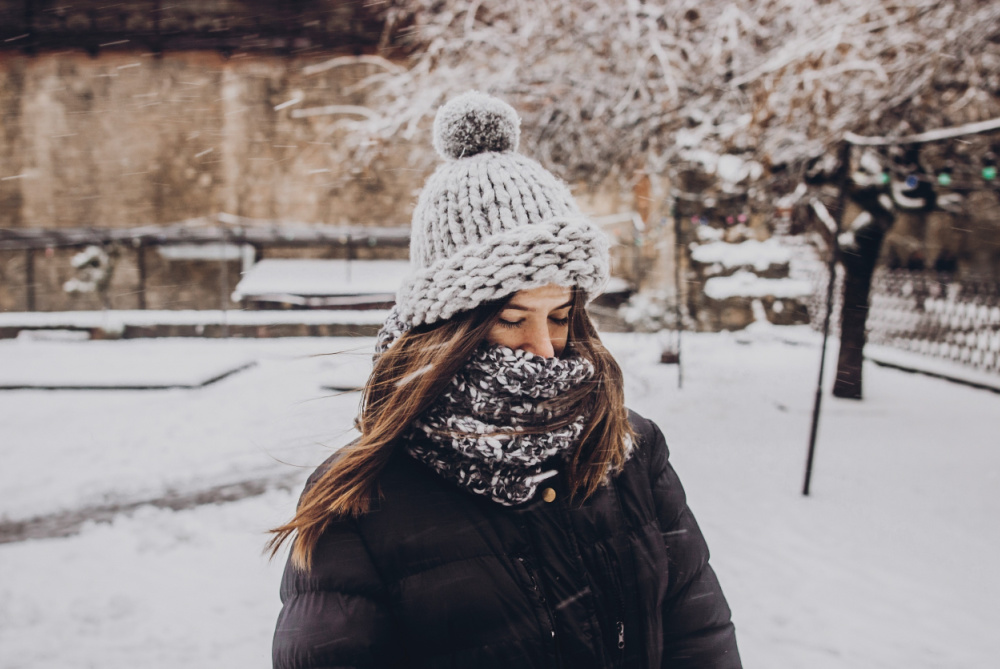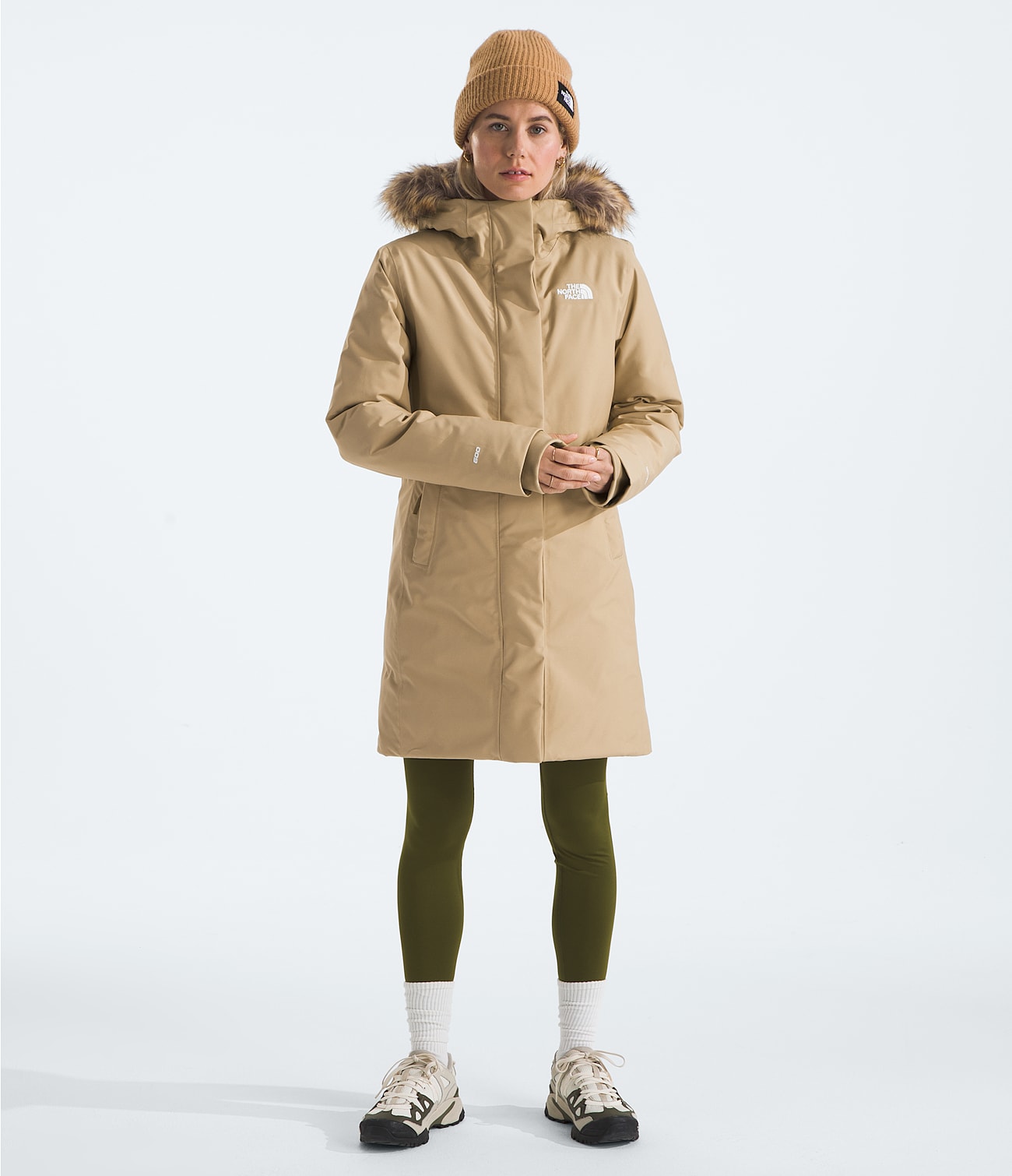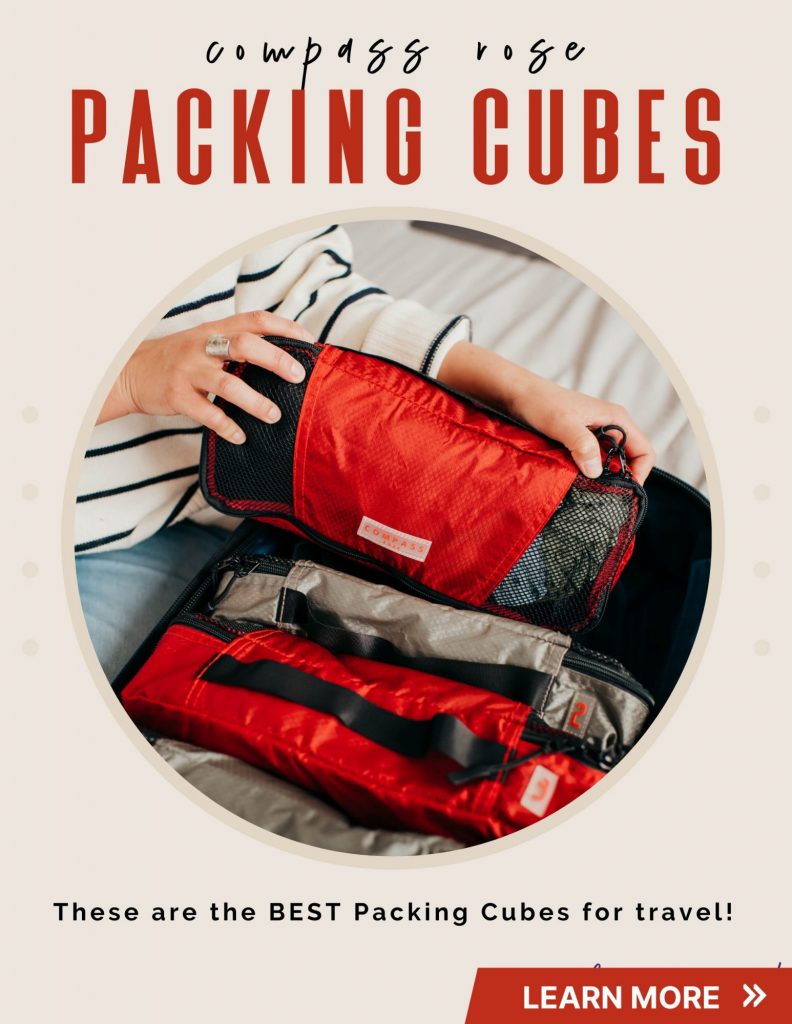Support TFG by using the links in our articles to shop. We receive a small commission (at no extra cost to you) so we can continue to create helpful free content. We earn from qualifying purchases made to the featured retailers. Thank you, we appreciate your support!
Traveling to a destination with subzero temperatures? Read these tips on how to choose the best arctic clothing to find out the best below zero clothing and gear for women!
Extreme Arctic Clothing Brand Ideas
by Anubha Momin
Table Of Contents
If you’re planning a trip to the Arctic or any destination where temperatures stay well below freezing for extended periods, you’ll need to come prepared. Extreme cold weather conditions require specialized clothing that not only keeps you warm but also allows you to remain comfortable and active. Whether you’re visiting Iqaluit in Canada, the remote landscapes of Iceland, or heading to the northernmost reaches of the world, packing the right gear can make all the difference.
As someone who calls Iqaluit, Canada’s Arctic capital, home, I can tell you that surviving the extreme cold is all about understanding the layers, the fabrics, and the gear that work best in such harsh environments.
Start by reading these general tips on packing for winter travel:
- Capsule Wardrobe for Winter
- How to Pack for Cold Weather
- How to Stay Warm in Cold Weather (without the bulk)
- The Best Travel Shoes for Winter
Here’s everything you need to know about Arctic clothing and cold-weather gear to ensure you stay warm and enjoy your adventure, no matter how freezing the conditions.
Outer Layer: The Key to Defending Against the Elements
When it comes to Arctic clothing, your outer layer is your most important piece of gear. This is your shield against the cold, wind, and snow, and it has to be top-notch.
Winter Coat
Your winter coat should be the first item on your packing list. Look for a coat that is both insulated and waterproof, as you’ll need protection from both the cold and any wet conditions. Opt for a down-filled jacket or one with synthetic insulation, both are excellent at trapping heat while remaining lightweight.
A down parka jacket is particularly cozy but can lose its insulating properties if it gets wet, so synthetic fill might be a better choice if you expect snow or rain. Make sure the coat is long enough to cover your hips and thighs to provide maximum warmth.
Arctix Women’s Insulated Snow Pant
Waterproof Pants
When traveling in the Arctic, your legs need protection just as much as your upper body. Waterproof, insulated pants are a must to keep snow, sleet, and moisture out while ensuring you stay warm.
These cold weather pants should be breathable, too, to allow moisture from sweat to escape without chilling you. If you plan on doing more active activities like skiing or hiking, choose pants designed for flexibility and movement.
BenBoy Fleece Slim Cargo Snow Ski Hiking Pants
Extra Layer – Ski Pants or Snow Pants
For those extra cold days or activities that demand more flexibility, such as snowshoeing or cross-country skiing, invest in snow-specific pants.
These are designed to allow maximum freedom of movement, but they’re also incredibly warm and often come with adjustable waistbands and breathable panels for ventilation.
Insulating Layers: How to Keep the Warmth In
In Arctic conditions, layering is crucial for staying warm. Insulating layers trap body heat while allowing you to adjust to changing temperatures.

Ridge Merino Aspect Midweight Long Sleeve | Ridge Merino Aspect Midweight Bottoms
Thermal Base Layers (Top & Bottom)
Base layers are essential for regulating body temperature in extreme cold. Choose thermal tops and bottoms made from merino wool, silk or synthetic fibers.
These materials are breathable and moisture-wicking, which means they’ll keep you dry by pulling sweat away from your skin. Merino wool is particularly excellent at regulating your body temperature and won’t make you feel cold and damp if you sweat.
The North Face Osito Classic Fleece Jacket
Fleece Jackets & Sweaters
A fleece jacket or sweaters, made from merino wool or cashmere, add an extra layer of warmth without adding weight to your suitcase.
Fleece is lightweight, soft, and insulating, making it ideal for an Arctic layering system. It allows for good breathability and is quick-drying, which is important if you’re moving between warm indoor environments and cold outdoor conditions.
Eddie Bauer CirrusLite Hooded Down Jacket
Down or Synthetic Insulated Jackets
A down jacket or synthetic insulated coat will provide that extra warmth you need when the temperatures plummet especially as you can also layer it under your winter jacket as needed.
Down is incredibly warm but can lose its insulation ability if it gets wet, which is why synthetic insulation is a good alternative for wet conditions. Both materials offer excellent warmth-to-weight ratios, so you won’t feel bogged down in too many layers.
Footwear: Keeping Your Feet Warm and Dry
When it’s freezing outside, your feet are one of the first places that can become uncomfortably cold. You’ll need boots that are specifically designed to handle extreme temperatures while providing ample insulation and waterproofing.
Columbia Ice Maiden II Snow Boot
Insulated Waterproof Boots
Your boots need to be rated for extreme cold temperatures, look for boots rated for -30°C or lower. They should also be waterproof, as moisture can quickly turn a cold day into an uncomfortable nightmare.
Insulated boots with thick soles and strong traction will help you stay balanced and prevent slipping on ice or snow. Choose boots that are both high enough to prevent snow from getting inside and roomy enough to allow for thick socks without restricting circulation.
Alvada Merino Wool Thermal Socks
Thermal Socks
Wool socks are your best bet for cold-weather adventures. These socks wick moisture away from your feet while keeping them warm, even in freezing conditions. They’re breathable and naturally odor-resistant, which is great if you’re out for long periods.
Pike Trail Waterproof Adjustable Leg Gaiters
Gaiters
If you’re planning to walk or hike in deep snow, gaiters are a game-changer. These waterproof covers slip over your boots and lower legs to keep snow, water, and cold from getting inside your shoes. Gaiters also help with insulation and prevent cold air from creeping up your pant legs.
Headgear: Protecting Your Head, Ears, and Face
When temperatures drop in the Arctic, your extremities are the most vulnerable. Your head, ears, and face can become frostbitten if you’re not careful, so protecting them is key.
Minus33 Unisex Merino Wool Cuff Beanie Hat
Insulated Hat or Beanie
A warm, insulated hat is a must-have for any Arctic adventure. Wool or fleece hats will keep your head and ears covered and warm. Look for hats with ear flaps or built-in fleece lining for extra insulation.
If you plan on spending a lot of time outside, make sure your winter hat fits comfortably under your coat’s hood and covers your ears completely.
Balaclava or Neck Gaiter
A balaclava is an excellent choice for extreme cold conditions, as it covers your face, neck, and head, leaving only your eyes exposed. This is essential if you’re going to be exposed to wind or subzero temperatures for extended periods.
If a balaclava isn’t your style, a neck gaiter or a scarf is a more versatile option—it can be worn around your neck for warmth or pulled up to cover your face when needed.
Brook + Bay Foldable & Furry Ear Muffs
Earmuffs or Fleece Headband
For those who prefer not to wear a full hat, earmuffs or a fleece headband can be a great way to protect your ears without sacrificing comfort or style. They’re lightweight, portable, and easy to pack, making them perfect for traveling.
Gloves: Essential for Keeping Your Fingers Functional
Cold hands can be a serious issue, especially when you’re trying to enjoy outdoor activities in the Arctic. Gloves that are both insulated and waterproof are essential.
Insulated Gloves
Your gloves need to be warm but also functional. Insulated gloves should allow you to move your fingers and use your gear without losing heat.
Go for gloves made with synthetic insulation, which performs well even in wet conditions, or down-filled options for maximum warmth. Choose gloves that are breathable to prevent sweating, but also have waterproof features to keep your hands dry.
Terramar Thermasilk Glove Liner
Glove Liners
Glove liners made of merino wool or fleece add an extra layer of warmth. They’re lightweight and can be worn underneath your main gloves for extra protection on super cold days. Look for liners that are moisture-wicking to keep your hands dry during physical activities.
Hand Warmers
If you need a little extra heat, hand warmers are an essential travel accessory. These small packets heat up when activated and can keep your fingers warm for hours. They’re portable and easy to tuck into your gloves or pockets for instant warmth.
Extra Tips for Staying Comfortable in the Cold
- Moisturize: The cold air in the Arctic can dry out your skin quickly. Be sure to bring a thick, nourishing moisturizer and lip balm with SPF to protect your skin from cracking and chapping.
- Hydration: Even in freezing temperatures, hydration is crucial. Carry an insulated water bottle to keep your water from freezing, and drink regularly to avoid dehydration.
- Goggles: If you’re planning on activities like snowmobiling or skiing, snow goggles are essential. They’ll protect your eyes from the glare of the snow and the harsh UV rays that reflect off the surface.
- Sunscreen: Yes, you need sunscreen in the Arctic. Snow reflects UV rays, so it’s easy to get sunburned even in cold temperatures. Apply SPF to exposed skin, especially your face, hands, and neck.
Prepare for the Cold, Embrace the Adventure
The Arctic is a breathtaking, remote part of the world, and the right clothing and gear can make all the difference in how you experience it. By focusing on layers, moisture-wicking fabrics, and high-quality gear that will keep you warm, dry, and protected, you can explore these stunning destinations without worrying about the cold.
So, pack wisely, layer up, and get ready to enjoy your Arctic adventure—whether you’re chasing the Northern Lights or simply soaking in the beautiful frozen landscape.





What extreme cold weather gear do you recommend? Share in the comments below!
For more ideas on what to wear in cold weather, please read:
- How to Pack for Cold Weather like a Boss
- Warmest Gloves for Cold Weather
- Cozy Winter Sweaters
- Cold Weather Pants for Winter Travel
LIKED THIS POST? PIN THIS PIC TO SAVE IT!

























Hi, I will go to Finland and Iceland in January next year, can you please give other recommendations.
Thank you,
Lisett
Hi Lisett, to get the best advice about what the weather is like at that time of the year, I would highly recommend that you join our TFG facebook group and post any questions you have there: https://www.facebook.com/groups/travelfashiongirls/
It’s a fabulous community of helpful female travelers that love to share their travel advice and recommendations.
Here are a few more resources to help you with packing light while staying warm when traveling in colder weather:
1. Thermals really are the secret to minimal packing with less bulk, they’re amazing: https://www.travelfashiongirl.com/best-thermal-underwear-for-women/
2. Here are some tips on how to layer them with your clothing to stay warm: https://www.travelfashiongirl.com/how-to-stay-warm-in-cold-weather/
3. This is a sample packing list for the cold: https://www.travelfashiongirl.com/how-to-pack-for-cold-weather/ You can use the principles to create your own capsule wardrobe according to your own clothing preferences, not necessarily to pack what is shown in the example.
Also have a look at this guide to packing for Finland: https://www.travelfashiongirl.com/what-to-wear-in-finland-in-winter/
Hope this helps and have an awesome time!
Hi Alex and Anubha,
I agree, the red parka is gorgeous! For what it’s worth, I became acquainted with the value of fur in the AF as they used to make real down parkas with fox or coyote fur around the hood. There are still a few camping and hunting places that carry coats made this way, and with fur trim. Also used to be able to get beautiful anoraks and mukluks from Alaska. I bought fur pieces from a
local hunter and have sewn pieces around all my heavy winter coat hoods!
It keeps ice and snow from freezing around your face and wrists. When the wind, snow and cold hit, you’ll be glad it’s there! Also added to my boot tops, gloves etc. where snow and wind get in.
Fake fur doesn’t work that way! 8,000 plus ft. In the Colorado mountains will teach this very fast!
Connie
You keep coming back to Marino wool. Only problem is, I’m allergic to wool. What do you recommend in place of that?
Hi Lisa, thank you for your question. Have a look at this article for some suggestions for alternatives to merino wool: https://www.travelfashiongirl.com/best-alternative-to-merino-wool/ If you are looking for thermals, you might like Terramar Thermasilk Silk Thermal Underwear which are made with 100% silk pointelle knit, you can find them here: https://www.travelfashiongirl.com/best-thermal-underwear-for-women/ Hope this helps. Happy travels! ?
What is the best coat for snowmobilers?
Hi Laura, thank you for your question. Would something like the Columbia Carson Pass Jacket work for snowmobilers: https://www.travelfashiongirl.com/columbia-jacket-review/ Sorry I could not have been of more help. For the best recommendations, I would highly suggest that you join our TFG facebook group and post your question there: https://www.facebook.com/groups/travelfashiongirls/ Its a fabulous community of helpful female travelers that have the best advice and recommendations to share. Happy travels! ?
Merino wool. Yes! Icebreaker layers in Europe in winter under elegant tops and skirts. Keep cosy while hunting in northern B.C. Layered under camo. I’ve used lightweight merino for back up in tropics, hike etc. Can go weeks no washing and still fresh. My go to layers.
Great tips Lynn!
Hi,
This post has definitely given me some things to think about for my upcoming trips to places that will be colder than my usual destinations. Thanks!
Glad it was helpful!
Hi,
bearing in mind that cotton is not good for next to your skin what type of ladies underpants do you recommend to wear underneath the thermal longjohns
I’m interested in the response to this too!
Hi Susan, thank you for reaching out. You might find this article interesting to learn what’s the best fabric for travel for different circumstances, including the best fabrics for cold weather, such as merino wool: https://www.travelfashiongirl.com/how-to-choose-the-best-fabrics-for-travel/ I would also highly recommend that you join TFG’s free facebook community and post your question there: https://www.facebook.com/groups/travelfashiongirls/ It is a fabulous group of helpful female travelers that have the best advice and suggestions to share. Hope this helps answer your question. Happy travels! ?
Thanks, for the packing tips!
What about bottoms? hard shell? soft shell? what kind of insulated pant layers are around? I’ve spent 2 weeks looking into the options and it seems that there are a lack of choices regarding a) Insulated b) waterproof c) extreme cold/severe temp. pants for women. Thoughts?
Layer, Layer, Layer. Wool or fleece base layers with softshell pants. You can add hard shell pants for waterproofing over the top. Or try something insulated on top from Rab or Patagonia. Outdoor Research makes excellent gear also.
I have found that I like to layer because it is easier to move than it is in one pair of very thick pants.
For extreme environments (mountaineering etc) you will be looking at a full down insulated suit.
Awesome tips!
I absolutely want that Red Parka that she is wearing, do you know where I could order or purchase this coat
thank you in advance
P.S. Continuation of my previous message. I’m looking for recommendations for extreme cold weather.
Hi Laurie, thanks for your question! Anubha, the author of this article, suggested to get polarized lenses to reduce glare from snow. She also wears goggles if she wants to block the wind. For brands she loves Oakley because they have lots of size and lens options. I hope this helps 🙂
Do you have any specific brand/style recommendations for sunglasses?
100% Wool is no good for cold climate
merino wool seems to be the preferred fabric for the outdoor brands – what do you prefer to use?
Where I live it is regularly -40C in the winter. I often wear 2 wool layers and wool socks, which I find keep me very warm, but of course I would wear a windproof insulated coat over top!
Thanks for all the tips. The only thing I object to is using animal fur. That means one of these native species is getting killed so its fur can be sewn in a jacket. There are faux furs that are warm enough. No need to kill a beautiful wolf!
Hi Bonnie! I don’t the animals are killed for fur. I believe Anubha explained that every part of the animal is used as a sustainable way of life in Iqaluit, Nunavut. It’s for survival more than fashion. Find out more on her blog about living in the arctic: http://findingtruenorth.ca/ Thanks!
I must know,That red (looks like a pullover?) with the fur.. Where did you get that?!? It is beautiful!!
I think she had it made but I’ll shoot her an email for you 🙂
Do you have any recommendations for winter coats/parkas to wear in -40C and below?
For the moment just the products mentioned in this blog post but I’ll post your question on Facebook to get more feedback for you. Please keep an eye out: https://www.facebook.com/TravelFashionGirl
Hi! I’ll be heading to Antarctica later this year. This list is helpful for extreme cold weather climates. Anything else I need to know specific to Antarctica? Thank you!
Hi Mimi, have you checked out Canada Goose? Very popular parka brand for extreme cold weather. They have a temperature rating system on their site so you can see which coats are best for what weather.